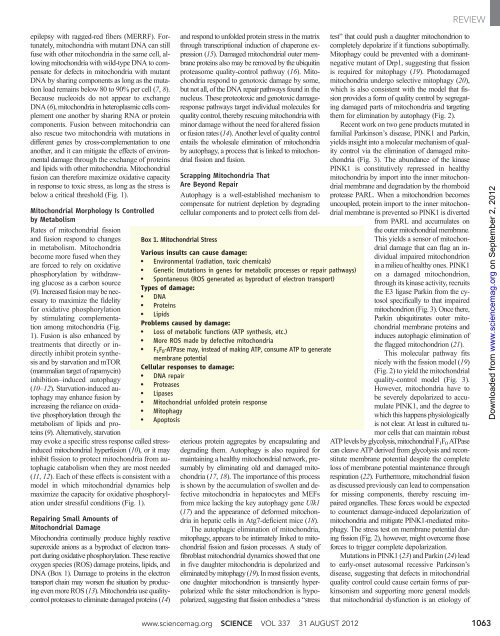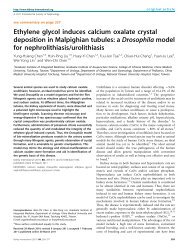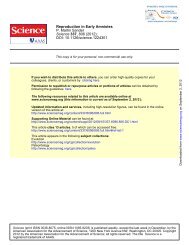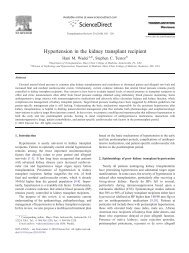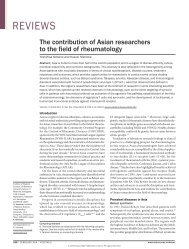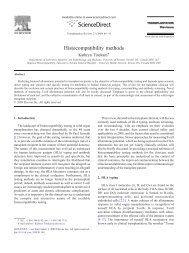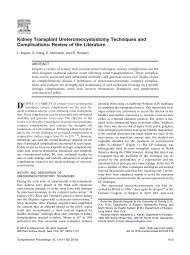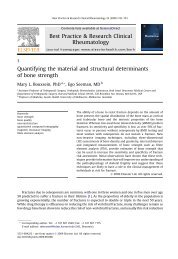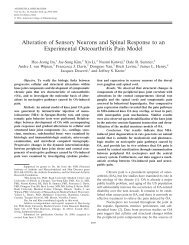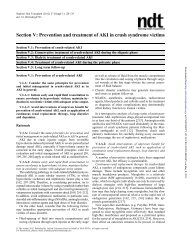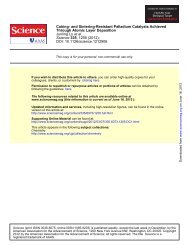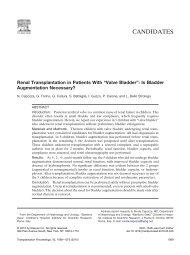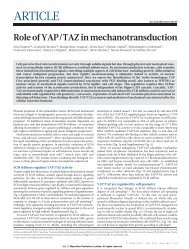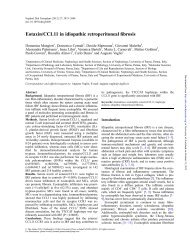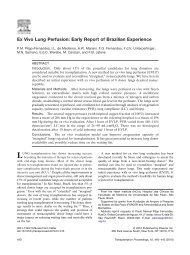Mitochondrial Fission, Fusion, and Stress
Mitochondrial Fission, Fusion, and Stress
Mitochondrial Fission, Fusion, and Stress
Create successful ePaper yourself
Turn your PDF publications into a flip-book with our unique Google optimized e-Paper software.
epilepsy with ragged-red fibers (MERRF). Fortunately,<br />
mitochondria with mutant DNA can still<br />
fuse with other mitochondria in the same cell, allowing<br />
mitochondria with wild-type DNA to compensate<br />
for defects in mitochondria with mutant<br />
DNA by sharing components as long as the mutationloadremainsbelow80to90%percell(7,<br />
8).<br />
Because nucleoids do not appear to exchange<br />
DNA (6), mitochondria in heteroplasmic cells complement<br />
one another by sharing RNA or protein<br />
components. <strong>Fusion</strong> between mitochondria can<br />
also rescue two mitochondria with mutations in<br />
different genes by cross-complementation to one<br />
another, <strong>and</strong> it can mitigate the effects of environmental<br />
damage through the exchange of proteins<br />
<strong>and</strong> lipids with other mitochondria. <strong>Mitochondrial</strong><br />
fusion can therefore maximize oxidative capacity<br />
in response to toxic stress, as long as the stress is<br />
below a critical threshold (Fig. 1).<br />
<strong>Mitochondrial</strong> Morphology Is Controlled<br />
by Metabolism<br />
Rates of mitochondrial fission<br />
<strong>and</strong> fusion respond to changes<br />
in metabolism. Mitochondria<br />
become more fused when they<br />
are forced to rely on oxidative<br />
phosphorylation by withdrawing<br />
glucose as a carbon source<br />
(9). Increased fusion may be necessary<br />
to maximize the fidelity<br />
for oxidative phosphorylation<br />
by stimulating complementation<br />
among mitochondria (Fig.<br />
1). <strong>Fusion</strong> is also enhanced by<br />
treatments that directly or indirectly<br />
inhibit protein synthesis<br />
<strong>and</strong> by starvation <strong>and</strong> mTOR<br />
(mammalian target of rapamycin)<br />
inhibition–induced autophagy<br />
(10–12). Starvation-induced autophagy<br />
may enhance fusion by<br />
increasing the reliance on oxidative<br />
phosphorylation through the<br />
metabolism of lipids <strong>and</strong> proteins<br />
(9). Alternatively, starvation<br />
may evoke a specific stress response called stressinduced<br />
mitochondrial hyperfusion (10), or it may<br />
inhibit fission to protect mitochondria from autophagic<br />
catabolism when they are most needed<br />
(11, 12). Each of these effects is consistent with a<br />
model in which mitochondrial dynamics help<br />
maximize the capacity for oxidative phosphorylation<br />
under stressful conditions (Fig. 1).<br />
Repairing Small Amounts of<br />
<strong>Mitochondrial</strong> Damage<br />
Mitochondria continually produce highly reactive<br />
superoxide anions as a byproduct of electron transport<br />
during oxidative phosphorylation. These reactive<br />
oxygen species (ROS) damage proteins, lipids, <strong>and</strong><br />
DNA (Box 1). Damage to proteins in the electron<br />
transport chain may worsen the situation by producing<br />
even more ROS (13). Mitochondria use qualitycontrol<br />
proteases to eliminate damaged proteins (14)<br />
<strong>and</strong> respond to unfolded protein stress in the matrix<br />
through transcriptional induction of chaperone expression<br />
(15). Damaged mitochondrial outer membrane<br />
proteins also may be removed by the ubiquitin<br />
proteasome quality-control pathway (16). Mitochondria<br />
respond to genotoxic damage by some,<br />
but not all, of the DNA repair pathways found in the<br />
nucleus. These proteotoxic <strong>and</strong> genotoxic damageresponse<br />
pathways target individual molecules for<br />
quality control, thereby rescuing mitochondria with<br />
minor damage without the need for altered fission<br />
or fusion rates (14). Another level of quality control<br />
entails the wholesale elimination of mitochondria<br />
by autophagy, a process that is linked to mitochondrial<br />
fission <strong>and</strong> fusion.<br />
Scrapping Mitochondria That<br />
Are Beyond Repair<br />
Autophagy is a well-established mechanism to<br />
compensate for nutrient depletion by degrading<br />
cellular components <strong>and</strong> to protect cells from del-<br />
Box 1. <strong>Mitochondrial</strong> <strong>Stress</strong><br />
Various insults can cause damage:<br />
Environmental (radiation, toxic chemicals)<br />
Genetic (mutations in genes for metabolic processes or repair pathways)<br />
Spontaneous (ROS generated as byproduct of electron transport)<br />
Types of damage:<br />
DNA<br />
Proteins<br />
Lipids<br />
Problems caused by damage:<br />
Loss of metabolic functions (ATP synthesis, etc.)<br />
More ROS made by defective mitochondria<br />
F 1F 0-ATPase may, instead of making ATP, consume ATP to generate<br />
membrane potential<br />
Cellular responses to damage:<br />
DNA repair<br />
Proteases<br />
Lipases<br />
<strong>Mitochondrial</strong> unfolded protein response<br />
Mitophagy<br />
Apoptosis<br />
eterious protein aggregates by encapsulating <strong>and</strong><br />
degrading them. Autophagy is also required for<br />
maintaining a healthy mitochondrial network, presumably<br />
by eliminating old <strong>and</strong> damaged mitochondria<br />
(17, 18). The importance of this process<br />
is shown by the accumulation of swollen <strong>and</strong> defective<br />
mitochondria in hepatocytes <strong>and</strong> MEFs<br />
from mice lacking the key autophagy gene Ulk1<br />
(17) <strong>and</strong> the appearance of deformed mitochondria<br />
in hepatic cells in Atg7-deficient mice (18).<br />
The autophagic elimination of mitochondria,<br />
mitophagy, appears to be intimately linked to mitochondrial<br />
fission <strong>and</strong> fusion processes. A study of<br />
fibroblast mitochondrial dynamics showed that one<br />
in five daughter mitochondria is depolarized <strong>and</strong><br />
eliminated by mitophagy (19). In most fission events,<br />
one daughter mitochondrion is transiently hyperpolarized<br />
while the sister mitochondrion is hypopolarized,<br />
suggesting that fission embodies a “stress<br />
REVIEW<br />
test” that could push a daughter mitochondrion to<br />
completely depolarize if it functions suboptimally.<br />
Mitophagy could be prevented with a dominantnegative<br />
mutant of Drp1, suggesting that fission<br />
is required for mitophagy (19). Photodamaged<br />
mitochondria undergo selective mitophagy (20),<br />
which is also consistent with the model that fission<br />
provides a form of quality control by segregating<br />
damaged parts of mitochondria <strong>and</strong> targeting<br />
them for elimination by autophagy (Fig. 2).<br />
Recent work on two gene products mutated in<br />
familial Parkinson’s disease, PINK1 <strong>and</strong> Parkin,<br />
yields insight into a molecular mechanism of quality<br />
control via the elimination of damaged mitochondria<br />
(Fig. 3). The abundance of the kinase<br />
PINK1 is constitutively repressed in healthy<br />
mitochondria by import into the inner mitochondrial<br />
membrane <strong>and</strong> degradation by the rhomboid<br />
protease PARL. When a mitochondrion becomes<br />
uncoupled, protein import to the inner mitochondrial<br />
membrane is prevented so PINK1 is diverted<br />
from PARL <strong>and</strong> accumulates on<br />
the outer mitochondrial membrane.<br />
This yields a sensor of mitochondrial<br />
damage that can flag an individual<br />
impaired mitochondrion<br />
in a milieu of healthy ones. PINK1<br />
on a damaged mitochondrion,<br />
through its kinase activity, recruits<br />
the E3 ligase Parkin from the cytosol<br />
specifically to that impaired<br />
mitochondrion (Fig. 3). Once there,<br />
Parkin ubiquitinates outer mitochondrial<br />
membrane proteins <strong>and</strong><br />
induces autophagic elimination of<br />
the flagged mitochondrion (21).<br />
This molecular pathway fits<br />
nicely with the fission model (19)<br />
(Fig. 2) to yield the mitochondrial<br />
quality-control model (Fig. 3).<br />
However, mitochondria have to<br />
be severely depolarized to accumulate<br />
PINK1, <strong>and</strong> the degree to<br />
which this happens physiologically<br />
is not clear. At least in cultured tumor<br />
cells that can maintain robust<br />
ATP levels by glycolysis, mitochondrial F 1F 0 ATPase<br />
can cleave ATP derived from glycolysis <strong>and</strong> reconstitute<br />
membrane potential despite the complete<br />
loss of membrane potential maintenance through<br />
respiration (22). Furthermore, mitochondrial fusion<br />
as discussed previously can lead to compensation<br />
for missing components, thereby rescuing impaired<br />
organelles. These forces would be expected<br />
to counteract damage-induced depolarization of<br />
mitochondria <strong>and</strong> mitigate PINK1-mediated mitophagy.<br />
The stress test on membrane potential during<br />
fission (Fig. 2), however, might overcome those<br />
forces to trigger complete depolarization.<br />
Mutations in PINK1 (23)<strong>and</strong>Parkin(24) lead<br />
to early-onset autosomal recessive Parkinson’s<br />
disease, suggesting that defects in mitochondrial<br />
quality control could cause certain forms of parkinsonism<br />
<strong>and</strong> supporting more general models<br />
that mitochondrial dysfunction is an etiology of<br />
www.sciencemag.org SCIENCE VOL 337 31 AUGUST 2012 1063<br />
Downloaded from<br />
www.sciencemag.org on September 2, 2012


